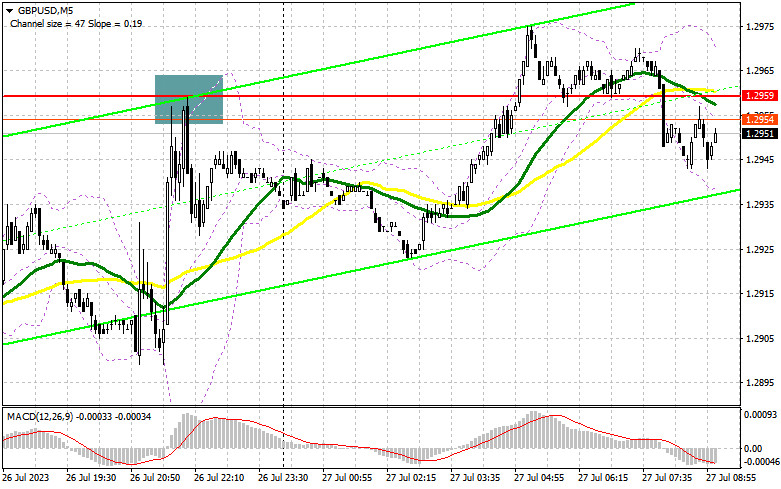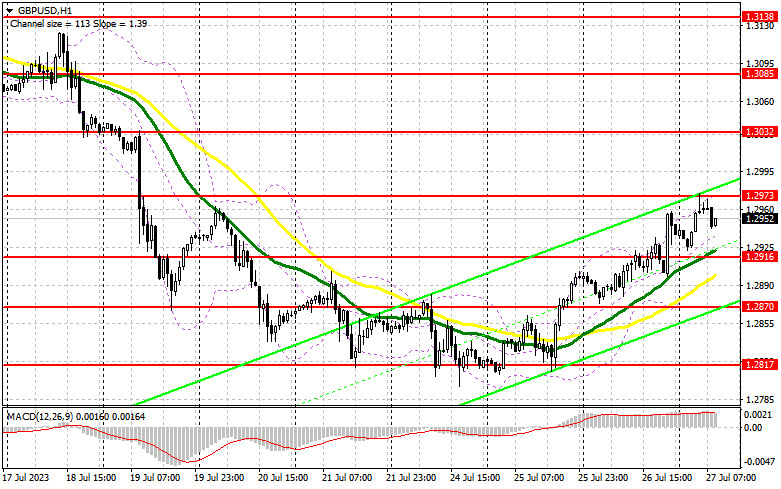
Yesterday, the instrument formed several market entry signals. Now let's look at the 5-minute chart and try to figure out what actually happened. Previously, I considered entering the market from the level of 1.2906. A growth and false breakout on this mark produced a sell signal, but since it was a bullish market, there was no significant decline. For this reason, I made the decision to leave the trade with no profit. In the afternoon, a false breakout at 1.2959 produced a great sell signal. As a result, the pound fell by about 20 pips.

For long positions on GBP/USD:
The Federal Reserve's decision had a positive impact on the pound's positions and led to the weakening of the US dollar. Today, the pair may continue to trade higher, but this requires good data on retail sales from the Confederation of British Industry, as well as protect the new support level at 1.2916, which is in line with the bullish moving averages. A false breakout at this mark will produce a buy signal, which can reinforce the pound sterling, allowing it to reach the nearest resistance level at 1.2973. A breakout and consolidation above this range will lead to renewed weekly highs and provide an additional buy signal with a rise to 1.3032. A more distant target will be the 1.3085 level where I recommend locking in profits.
If GBP/USD falls and there are no bulls at 1.2916, pressure on the pound will increase. In this case, only the protection of 1.2870, as well as a false breakout on this mark, will create new entry points into long positions. You could buy GBP/USD at a bounce from 1.2817, keeping in mind an upward intraday correction of 30-35 pips.
For short positions on GBP/USD:
The bears retreated after failing to hear aggressive signals from Fed Chair Jerome Powell. Now it is very important for them to defend the resistance level at 1.2973, which has already been tested in today's Asian session. In case the pair rises in the first half of the day, a false breakout of this mark will form a sell signal to continue the bearish correction with 1.2916 as the target. A breakout and an upward retest of this range will create an entry point for short positions, potentially sending the pair down to 1.2870. A more distant target will be the low of 1.2817, where I will take profits.

If GBP/USD rises and there is no activity at 1.2973, the sellers will waste some of their initiative and the buyers will start to gradually return to the market again as they count on the increasing divergence between the monetary policies of the Fed and the BoE. In this case, I would advise you to postpone short positions until a test of the resistance level of 1.3032. A false breakout there will generate an entry point into short positions. If there is no downward movement there, you could sell the pound sterling at a bounce from 1.3085, keeping in mind a downward intraday correction of 30-35 pips.
COT report:
According to the COT report (Commitment of Traders) for July 18th, there was a significant increase in both long and short positions. Traders started returning to the market after the release of several fundamental data releases, indicating the UK economy is in a somewhat stable state, which is gradually sagging under the pressure of high interest rates. The sharp decline in inflation in the US prompted a GBP upsurge. However, its overbought state, coupled with the central bank's hawkish policies, raises concerns about future labor and housing market problems in the UK. Bearish are taking advantage of this by increasing their short positions at any opportune moment, as evident from the COT report. Recent PMI reports also point to growing issues. This week, the Federal Reserve will hold its policy meeting, and if there's an announcement about concluding the cycle of interest rate hikes, the pound sterling may rise again. Buying the pound on dips remains the optimal strategy. According to the latest COT report, non-commercial long positions increased by 23,602 to 135,269, while non-commercial short positions jumped by 17,936 to 71,540. This led to another upward surge in the non-commercial net position, which reached 63,729 compared to 58,063 the previous week. The weekly price rose to 1.3049 from 1.2932.
Indicator signals:
Moving Averages
Trading is carried out above the 30-day and 50-day moving averages, which indicates a further rise.
Note: The period and prices of moving averages are considered by the author on the one-hour chart that differs from the general definition of the classic daily moving averages on the daily chart.
Bollinger Bands
If GBP/USD declines, the indicator's lower border near 1.2895 will serve as support.
Description of indicators:
• A moving average of a 50-day period determines the current trend by smoothing volatility and noise; marked in yellow on the chart;
• A moving average of a 30-day period determines the current trend by smoothing volatility and noise; marked in green on the chart;
• MACD Indicator (Moving Average Convergence/Divergence) Fast EMA with a 12-day period; Slow EMA with a 26-day period. SMA with a 9-day period;
• Bollinger Bands: 20-day period;
• Non-commercial traders are speculators such as individual traders, hedge funds, and large institutions who use the futures market for speculative purposes and meet certain requirements;
• Long non-commercial positions represent the total number of long positions opened by non-commercial traders;
• Short non-commercial positions represent the total number of short positions opened by non-commercial traders;
• The non-commercial net position is the difference between short and long positions of non-commercial traders.